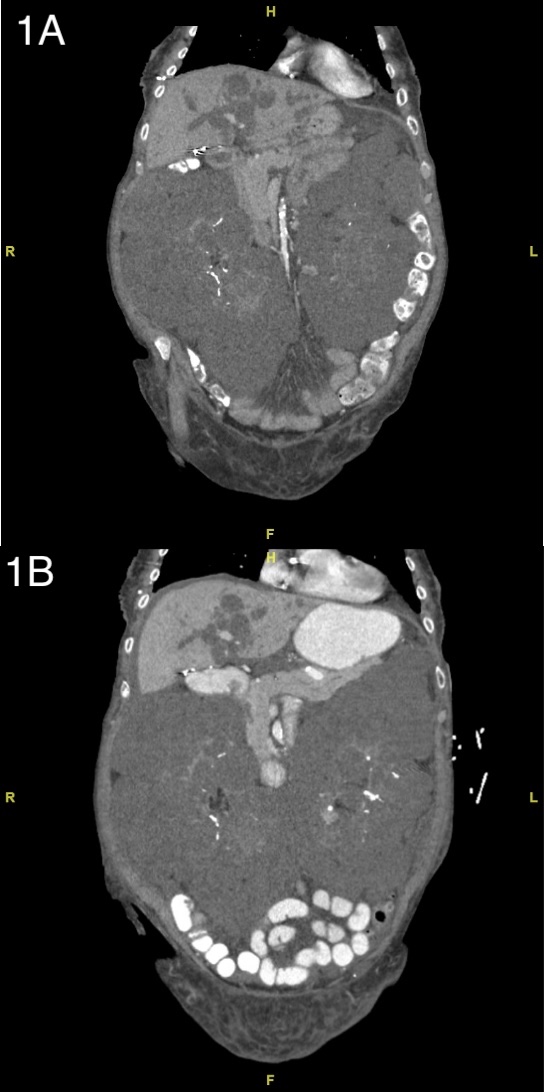Monday Poster Session
Category: Liver
P4003 - Cholangiocarcinoma in a Patient with End-Stage Autosomal Dominant Polycystic Kidney Disease
Monday, October 27, 2025
10:30 AM - 4:00 PM PDT
Location: Exhibit Hall

Diego J. Duran Baez, MD (he/him/his)
Mount Sinai South Nassau,Icahn School of Medicine at Mount Sinai
Uniondale, NY
Presenting Author(s)
Diego J. Duran Baez, MD1, Rashmi Advani, MD2, Jonathan Vincent M Reyes, MD2, Frank G. Gress, MD, MBA2
1Mount Sinai South Nassau,Icahn School of Medicine at Mount Sinai, Uniondale, NY; 2Mount Sinai South Nassau,Icahn School of Medicine at Mount Sinai, Oceanside, NY
Introduction: Cholangiocarcinoma (CCA) is a broad group of biliary epithelial malignancies that can occur de novo or in association of multiple known risk factors. Autosomal dominant polycystic kidney disease (ADPKD), although not a known risk factor for CCA, is known to increase risk of biliary tract complications. We report a case of a patient with end-stage ADPKD and no known established risk factors diagnosed with de novo CCA.
Case Description/
Methods: An 85-year-old female with medical history of ADPKD requiring dialysis presented to the emergency department for abnormally elevated liver enzymes on outpatient lab work. Physical exam on admission was remarkable for painless jaundice. Chronic liver disease workup including alpha-1-antitrypsin, viral hepatitis serologies, ANA, AMA were all negative, but CA 19-9 and CEA were elevated. A CT of the abdomen was remarkable for interval increase in intrahepatic biliary duct dilation with a stable common bile duct size compared to a previous scan performed 5 months prior to this arrival (Figure 1). A subsequent MRCP did not show any visible obstructing stones or enhancing lesions. ERCP performed after found severely strictured and narrowed hepatic bifurcation lumen. The surrounding tissue was biopsied and biliary stents were placed. Biopsy results showed infiltrating poorly differentiated carcinoma, consistent with biliary tract carcinoma. Immunohistochemistry stains showed positive expression of CAM5.2 cytokeratin, Cytokeratin 7, CEA, and CA 19-9. The patient was determined not to be a candidate for chemotherapy and was referred for radiation therapy.
Discussion: Our case highlights the importance of continued research on risk factors and workup of CCA. CCA is an aggressive and difficult-to-treat malignancy that is associated with risk factors such as hepatholithiasis, biliary fluke infections, and biliary cysts. These are believed to affect multiple signaling pathways as well as contribute to longstanding inflammation of the biliary epithelium that can predispose to dysplasia. The increased risk of biliary disease from ADPKD may contribute to this as well.

Figure: Figure 1: CT abdomen and pelvis performed on admission showing interval increased intrahepatic duct dilation (1A) compared to prior study performed 5 months ago (1B)
Disclosures:
Diego J. Duran Baez indicated no relevant financial relationships.
Rashmi Advani indicated no relevant financial relationships.
Jonathan Vincent M Reyes indicated no relevant financial relationships.
Frank Gress indicated no relevant financial relationships.
Diego J. Duran Baez, MD1, Rashmi Advani, MD2, Jonathan Vincent M Reyes, MD2, Frank G. Gress, MD, MBA2. P4003 - Cholangiocarcinoma in a Patient with End-Stage Autosomal Dominant Polycystic Kidney Disease, ACG 2025 Annual Scientific Meeting Abstracts. Phoenix, AZ: American College of Gastroenterology.
1Mount Sinai South Nassau,Icahn School of Medicine at Mount Sinai, Uniondale, NY; 2Mount Sinai South Nassau,Icahn School of Medicine at Mount Sinai, Oceanside, NY
Introduction: Cholangiocarcinoma (CCA) is a broad group of biliary epithelial malignancies that can occur de novo or in association of multiple known risk factors. Autosomal dominant polycystic kidney disease (ADPKD), although not a known risk factor for CCA, is known to increase risk of biliary tract complications. We report a case of a patient with end-stage ADPKD and no known established risk factors diagnosed with de novo CCA.
Case Description/
Methods: An 85-year-old female with medical history of ADPKD requiring dialysis presented to the emergency department for abnormally elevated liver enzymes on outpatient lab work. Physical exam on admission was remarkable for painless jaundice. Chronic liver disease workup including alpha-1-antitrypsin, viral hepatitis serologies, ANA, AMA were all negative, but CA 19-9 and CEA were elevated. A CT of the abdomen was remarkable for interval increase in intrahepatic biliary duct dilation with a stable common bile duct size compared to a previous scan performed 5 months prior to this arrival (Figure 1). A subsequent MRCP did not show any visible obstructing stones or enhancing lesions. ERCP performed after found severely strictured and narrowed hepatic bifurcation lumen. The surrounding tissue was biopsied and biliary stents were placed. Biopsy results showed infiltrating poorly differentiated carcinoma, consistent with biliary tract carcinoma. Immunohistochemistry stains showed positive expression of CAM5.2 cytokeratin, Cytokeratin 7, CEA, and CA 19-9. The patient was determined not to be a candidate for chemotherapy and was referred for radiation therapy.
Discussion: Our case highlights the importance of continued research on risk factors and workup of CCA. CCA is an aggressive and difficult-to-treat malignancy that is associated with risk factors such as hepatholithiasis, biliary fluke infections, and biliary cysts. These are believed to affect multiple signaling pathways as well as contribute to longstanding inflammation of the biliary epithelium that can predispose to dysplasia. The increased risk of biliary disease from ADPKD may contribute to this as well.

Figure: Figure 1: CT abdomen and pelvis performed on admission showing interval increased intrahepatic duct dilation (1A) compared to prior study performed 5 months ago (1B)
Disclosures:
Diego J. Duran Baez indicated no relevant financial relationships.
Rashmi Advani indicated no relevant financial relationships.
Jonathan Vincent M Reyes indicated no relevant financial relationships.
Frank Gress indicated no relevant financial relationships.
Diego J. Duran Baez, MD1, Rashmi Advani, MD2, Jonathan Vincent M Reyes, MD2, Frank G. Gress, MD, MBA2. P4003 - Cholangiocarcinoma in a Patient with End-Stage Autosomal Dominant Polycystic Kidney Disease, ACG 2025 Annual Scientific Meeting Abstracts. Phoenix, AZ: American College of Gastroenterology.
